Wheatgrass is very easy to grow at home for juice or drying. Learn how to grow your own continuous supply of fresh wheatgrass.
HOW TO GROW WHEATGRASS AT HOME :-
STEP 1: GATHER ALL MATERIALS NEEDED
STEP 2: FILL YOUR CHOICE OF CONTAINER WITH THE SEED SOWING MIX
STEP 3: SPREAD SEEDS
STEP 4: RAKE AND COVER
STEP 5: WATER.
STEP 6: PLACE AT A COVERED LOCATION
STEP 7: HARVEST
7 STEPS to grow wheatgrass at home; you need –
- A container to grow in. Anything wide and moderately shallow does the job. If your container has drainage, it’s good; if it doesn’t but is deep enough, that is good too. Also, you can have some additional drainage by adding a layer of gravel at the bottom. You can even poke a hole at the bottom of a some plastic container to use it for sowing the seeds.
- Wheat seeds(grains). Most people buy their own bags of wheat for flouring and i just snag some from my parents’ stock(it comes from their own fields, so i know it is largely chemical-free)
- Seed sowing mix. THIS is important. An ideal mix is free from weed seeds and is light-weight to allow the roots to grow. Hence, i mix the following- compost, garden soil(with sand) and cocopeat.
- Spray bottle or your hands to gently water the seeds.
- FILL YOUR CHOICE OF CONTAINER WITH THE SEED SOWING MIX – Leave about 1″ at the top for watering and covering the seeds. Do not leave a lot of space on top or it will become difficult to harvest the blades later.
- SPREAD SEEDS – The seeds must be thickly sown to get a lush harvest, but also not overlapping.
- RAKE AND COVER – Lightly fork the seeds into the soil and cover with a layer of cocopeat. It helps preserve moisture for germination and prevent unsightly fungus on top layer. Take care that while the seeds should not be visible, they must also not be sown too deep.
- WATER – Use a spray bottle or your hands to moisten the top few inches of the soil. Do this gently so that the seeds do not float around.
- PLACE AT A COVERED LOCATION – The seeds should get ample daylight but not direct sun or rain. We neither want them to dry out not be flooded if it rains.
- HARVEST – In about 3-4 days, the blades should have grown tall enough(2-3″) for harvesting. Use a knife or a clean scissor to harvest the blades early in the morning.
TIPS TO GROW WHEATGRASS EASILY AT HOME
- The most important thing to do is sow in succession for a constant supply. This means, allot 5-6 containers and sow one, each day, so that you may get fresh harvest everyday.
- Never, under any circumstance, allow water to flood or stand in the container. This way the seeds/seedlings may rot or wash away. Protect it from direct rain.
- If the container is just shallow enough for the roots, ensure proper drainage.
- Use the freshest seeds and check for rot before sowing.
- If you feel that water isn’t draining down quickly, add some sand to aid drainage.
- The color of cocopeat is a measure of moisture level. Dry cocopeat is light brown, which means it needs water. Wet is dark brown.
- While watering, ensure that there is enough water to reach and wet the seeds not just the top.
HOW TO MAKE WHEATGRASS JUICE AT HOME
Crush the blades in a blender/mixie with some water. It will turn into a paste. Filter this paste through a strainer to obtain wheatgrass juice. Consume fresh.
HOW TO IMPROVE THE TASTE OF WHEATGRASS JUICE
Some people(like me) find the taste and smell extremely repulsive and bitter. If your doctor suggests, or if you are not consuming it for any specific ailment, you can add fresh orange juice or apple juice to it to make it palatable.
CAN YOU REUSE SAME BATCH OF WHEATGRASS TO MAKE JUICE SECOND TIME?
You may take a second harvest from the same pot, but it won’t be as lush and nutritious as the first one. So, the best thing to do is re-sow once harvested.
To do this, empty the potting mix onto a flat surface and let it sun-dry for a day. Strain it to remove leftover seeds, add some compost and reuse. Meanwhile, fill the original container with a fresh mix and re-sow seeds. So technically you will have to keep sowing seeds every day or on alternate days, max., to ensure a regular supply. It may sound tiresome but it isn’t if you keep the potting mix ready in bulk. Also, the hard-work is definitely worth it!
Till then,
HAPPY GARDENING 🙂
JOIN OUR GARDENING COMMUNITY ON FB FOR MORE TIPS AND TRICKS!

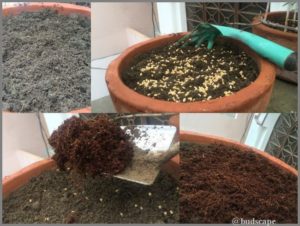
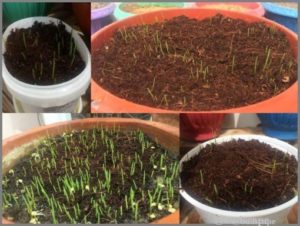
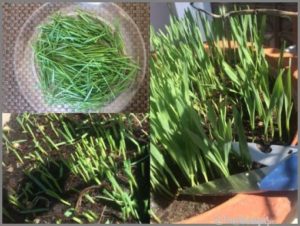
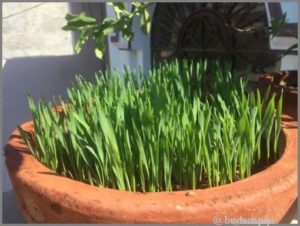
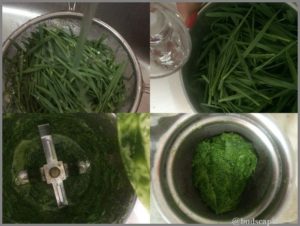

Keep bringing more, thanks for sharing!!
Can you please which wheatgrass seeds good to grow, organic or hybrid